April 1968 lunar eclipse
| Total Lunar Eclipse April 13, 1968 | |
|---|---|
| (No photo) | |
 The moon passes west to east (right to left) across the Earth's umbral shadow, shown in hourly intervals. | |
| Series | 131 (31 of 72) |
| Duration (hr:mn:sc) | |
| Totality | |
| Partial | |
| Penumbral | |
| Contacts | |
| P1 | UTC |
| U1 | |
| U2 | |
| Greatest | |
| U3 | |
| U4 | |
| P4 | |
A total lunar eclipse took place on April 13, 1968, the first of two total eclipses in 1968, the second being on October 6.
Visibility
It was visible from North and South America, as well as Africa and western Europe.

Related lunar eclipses
Lunar year series
| Descending node | Ascending node | |||||
|---|---|---|---|---|---|---|
| Saros | Date Viewing |
Type Chart |
Saros | Date Viewing |
Type Chart | |
| 111 | 1966 May 4 |
Penumbral |
116 | 1966 Oct 29 |
Penumbral | |
| 121 | 1967 Apr 24 |
Total |
126 | 1967 Oct 18 |
Total | |
| 131 | 1968 Apr 13 |
Total |
136 | 1968 Oct 6 |
Total | |
| 141 | 1969 Apr 2 |
Penumbral |
146 | 1969 Sep 25 |
Penumbral | |
| Last set | 1965 Jun 14 | Last set | 1965 Dec 8 | |||
| Next set | 1970 Feb 21 | Next set | 1969 Aug 27 | |||
Saros series
It is the second total lunar eclipse of the series.
Lunar Saros series 131, has 72 lunar eclipses.
This eclipse series began in AD 1427 with a partial eclipse at the southern edge of the Earth's shadow when the Moon was close to its descending node. Each successive Saros cycle, the Moon's orbital path is shifted northward with respect to the Earth's shadow, with the first total eclipse occurring in 1950. For the following 252 years, total eclipses occur, with the central eclipse being predicted to occur in 2078. The first partial eclipse after this is predicted to occur in the year 2220, and the final partial eclipse of the series will occur in 2707. The total lifetime of the lunar Saros series 131 is 1280 years.
Because of the ⅓ fraction of days in a Saros cycle, the visibility of each eclipse will differ for an observer at a given fixed locale. For the lunar Saros series 131, the first total eclipse of 1950 had its best visibility for viewers in Eastern Europe and the Middle East because mid-eclipse was at 20:44 UT. The following eclipse in the series occurred approximately 8 hours later in the day with mid-eclipse at 4:47 UT, and was best seen from North America and South America. The third total eclipse occurred approximately 8 hours later in the day than the second eclipse with mid-eclipse at 12:43 UT, and had its best visibility for viewers in the Western Pacific, East Asia, Australia and New Zealand. This cycle of visibility repeats from the initiation to termination of the series, with minor variations.
| Greatest | First | |||
|---|---|---|---|---|
 The greatest eclipse of the series will occur on 2094 Jun 28, lasting 102 minutes.[1] |
Penumbral | Partial | Total | Central |
| 1427 May 10 | 1553 July 25 | 1950 Apr 2 | 2022 May 16 | |
| Last | ||||
| Central | Total | Partial | Penumbral | |
| 2148 Jul 31 | 2202 Sep 3 | 2563 Apr 9 | 2707 Jul 7 | |
| 1914 Mar 12 | 1932 Mar 22 | 1950 Apr 2 | |||
 |
 |
 |
 |
 |
 |
| 1968 Apr 13 | 1986 Apr 24 | 2004 May 4 | |||
 |
 |
 |
 |
 |
 |
| 2022 May 16 | 2040 May 26 | 2058 Jun 6 | |||
 |
 |
 |
 |
 |
 |
| 2076 Jun 17 | 2094 Jun 28 | ||||
 |
 |
 |
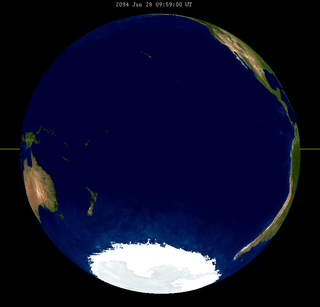 | ||
Inex series
The inex series repeats eclipses 20 days short of 29 years, repeating on average every 10571.95 days. This period is equal to 358 lunations (synodic months) and 388.5 draconic months. Saros series increment by one on successive Inex events and repeat at alternate ascending and descending lunar nodes.
This period is 383.6734 anomalistic months (the period of the Moon's elliptical orbital precession). Despite the average 0.05 time-of-day shift between subsequent events, the variation of the Moon in its elliptical orbit at each event causes the actual eclipse time to vary significantly.
| Descending node | Ascending node | Descending node | Ascending node | ||||
|---|---|---|---|---|---|---|---|
| Saros | Date Chart |
Saros | Date Chart |
Saros | Date Chart |
Saros | Date Chart |
| 115 | 1505 Feb 18 |
116 | 1534 Jan 30 |
117 | 1563 Jan 9 | 118 | 1591 Dec 30 |
| 119 | 1620 Dec 9 | 120 | 1649 Nov 19 | 121 | 1678 Oct 29 | 122 | 1707 Oct 11 |
| 123 | 1736 Sep 20 | 124 | 1765 Aug 30 | 125 | 1794 Aug 11 | 126 | 1823 Jul 23 |
| 127 | 1852 Jul 1 | 128 | 1881 Jun 12 | 129 | 1910 May 24 |
130 | 1939 May 3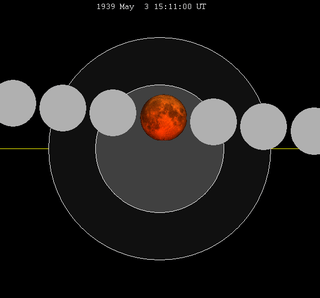 |
| 131 | 1968 Apr 13 |
132 | 1997 Mar 24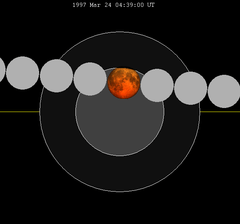 |
133 | 2026 Mar 3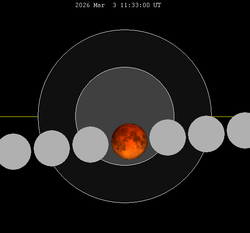 |
134 | 2055 Feb 11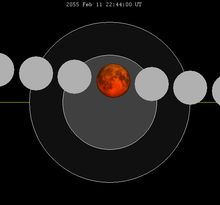 |
| 135 | 2084 Jan 22 |
136 | 2113 Jan 2 | 137 | 2141 Dec 13 | 138 | 2170 Nov 23 |
| 139 | 2199 Nov 2 | 140 | 2228 Oct 14 | 141 | 2257 Sep 24 | 142 | 2286 Sep 3 |
| 143 | 2315 Aug 16 | 144 | 2344 Jul 26 | 145 | 2373 Jul 5 | 146 | 2402 Jun 16 |
| 147 | 2431 May 27 | 148 | 2460 May 5 |
149 | 2489 Apr 16 | ||
See also
Notes
External links
- 1968 Apr 13 chart Eclipse Predictions by Fred Espenak, NASA/GSFC

